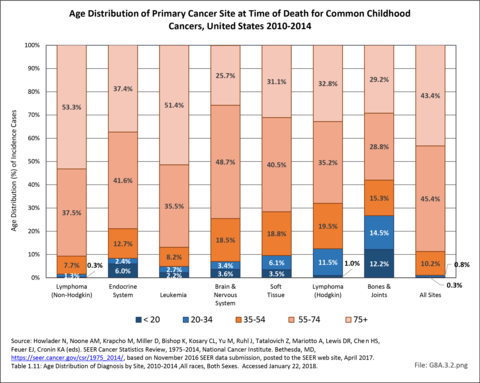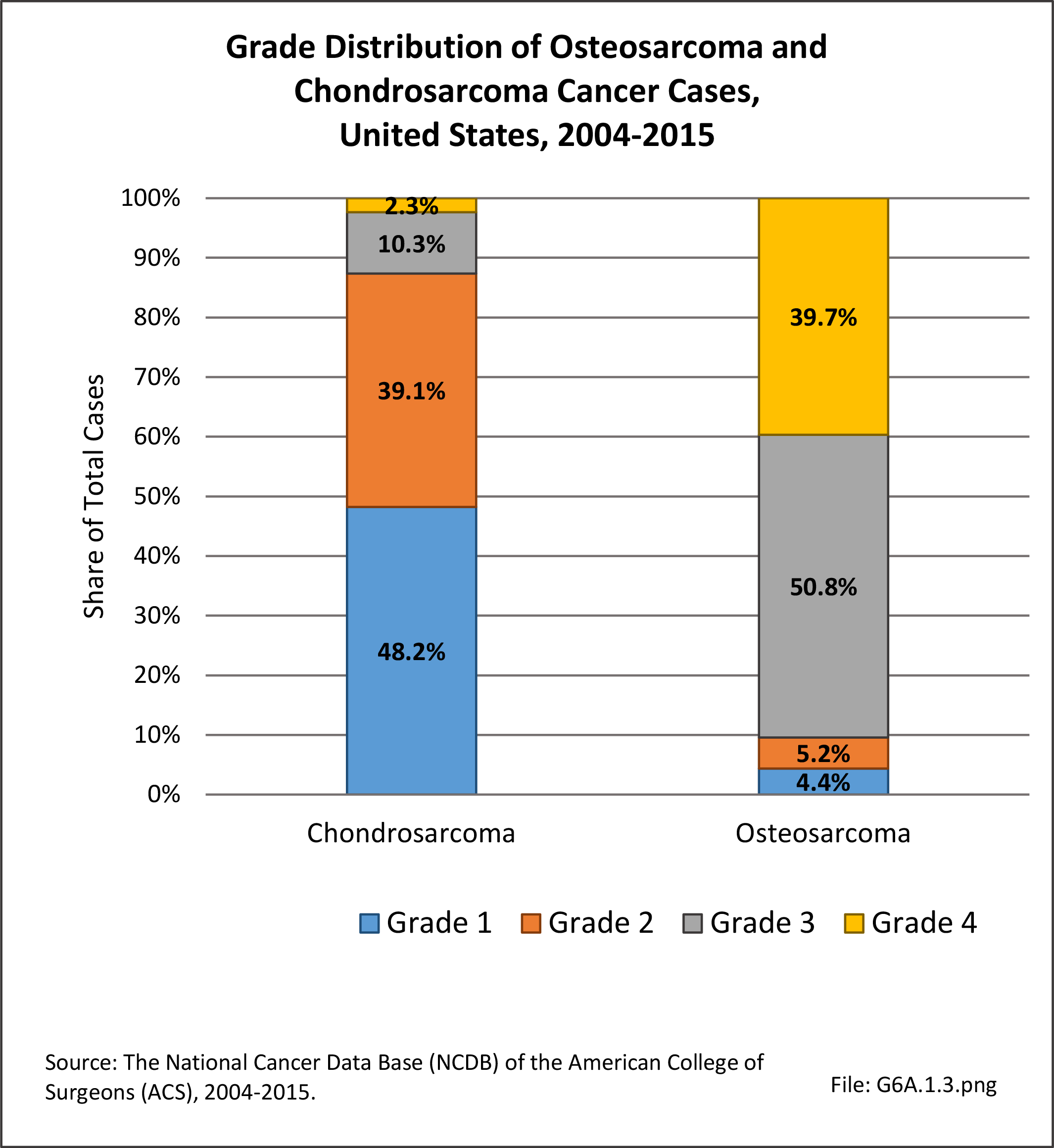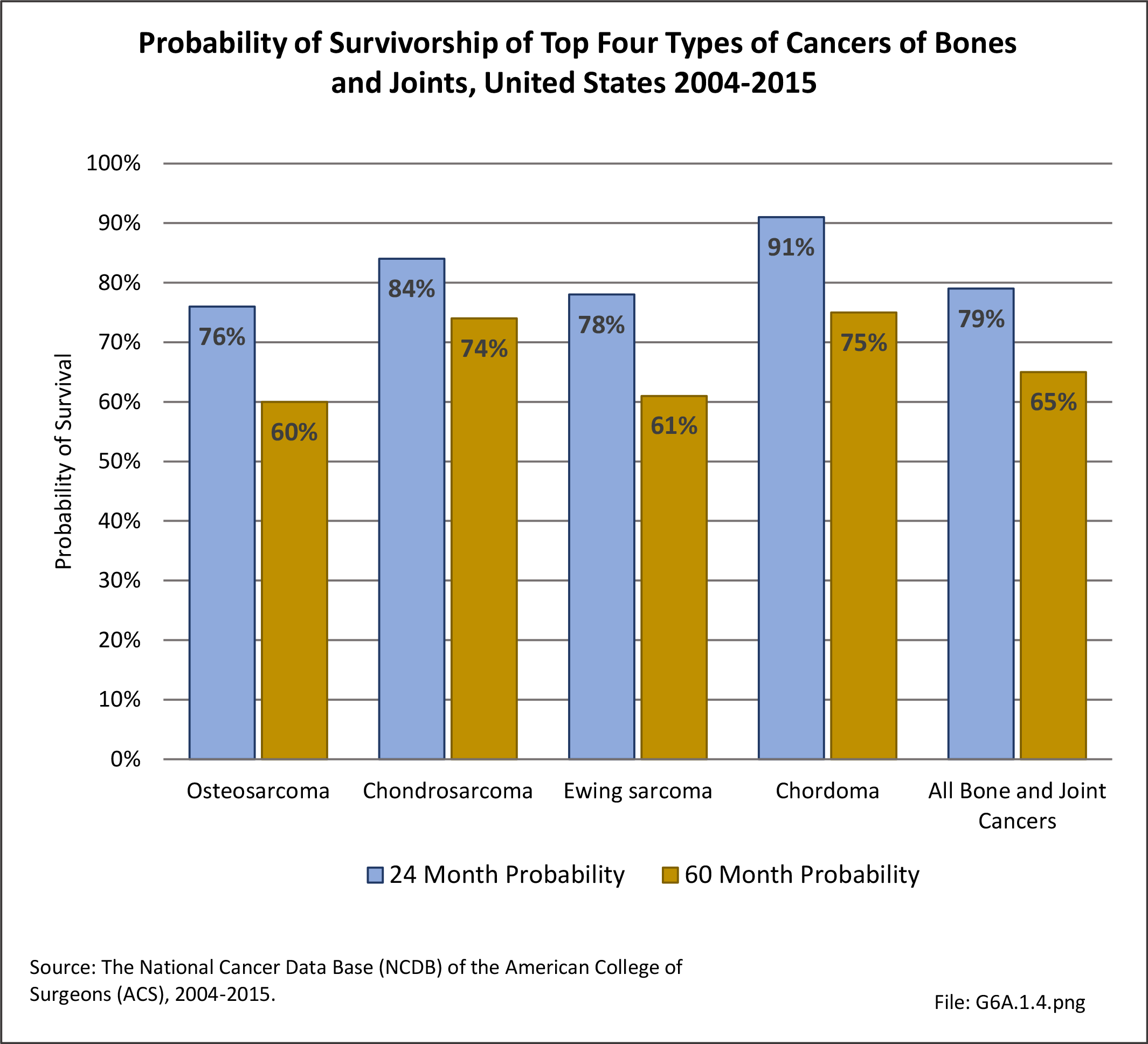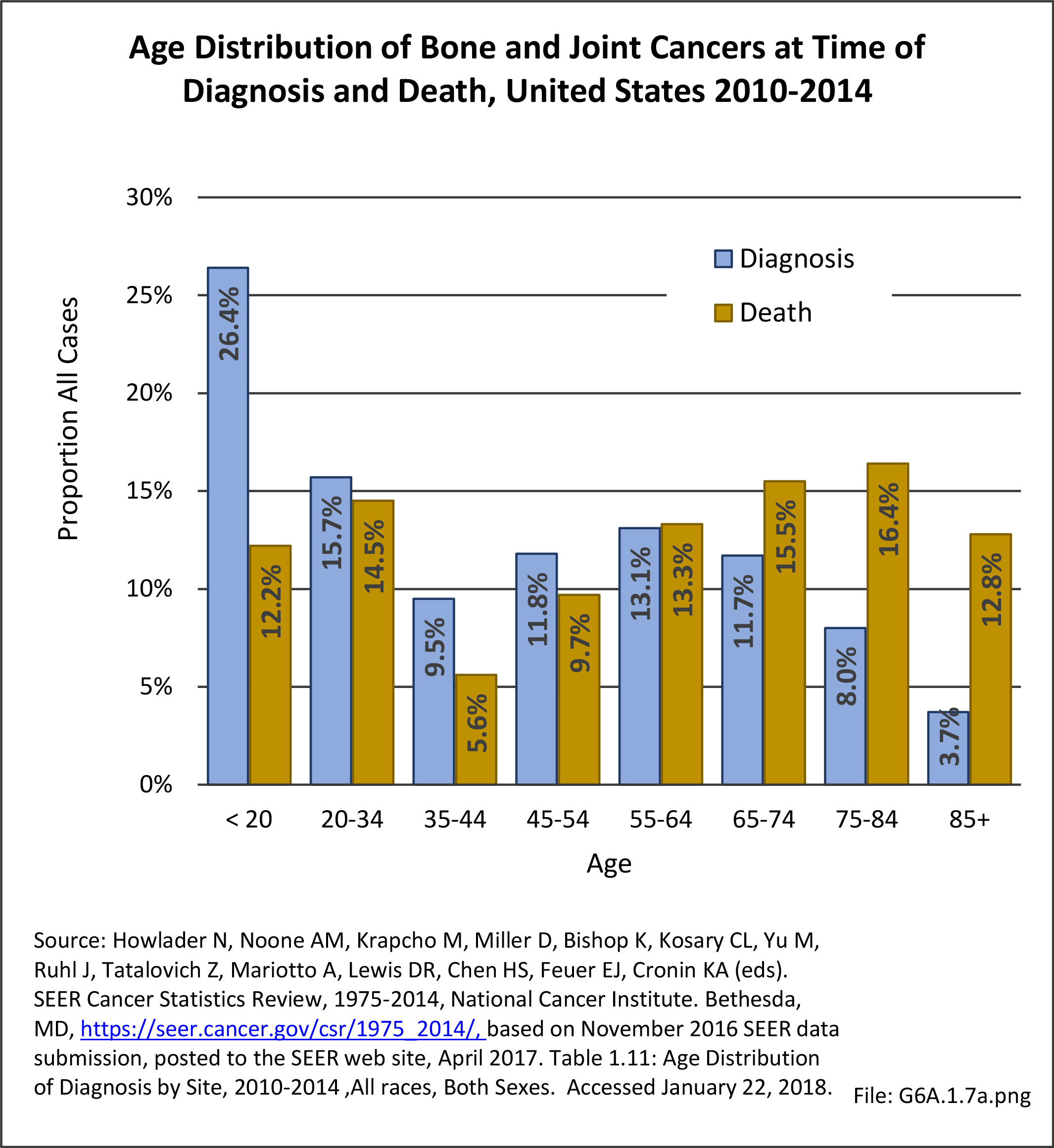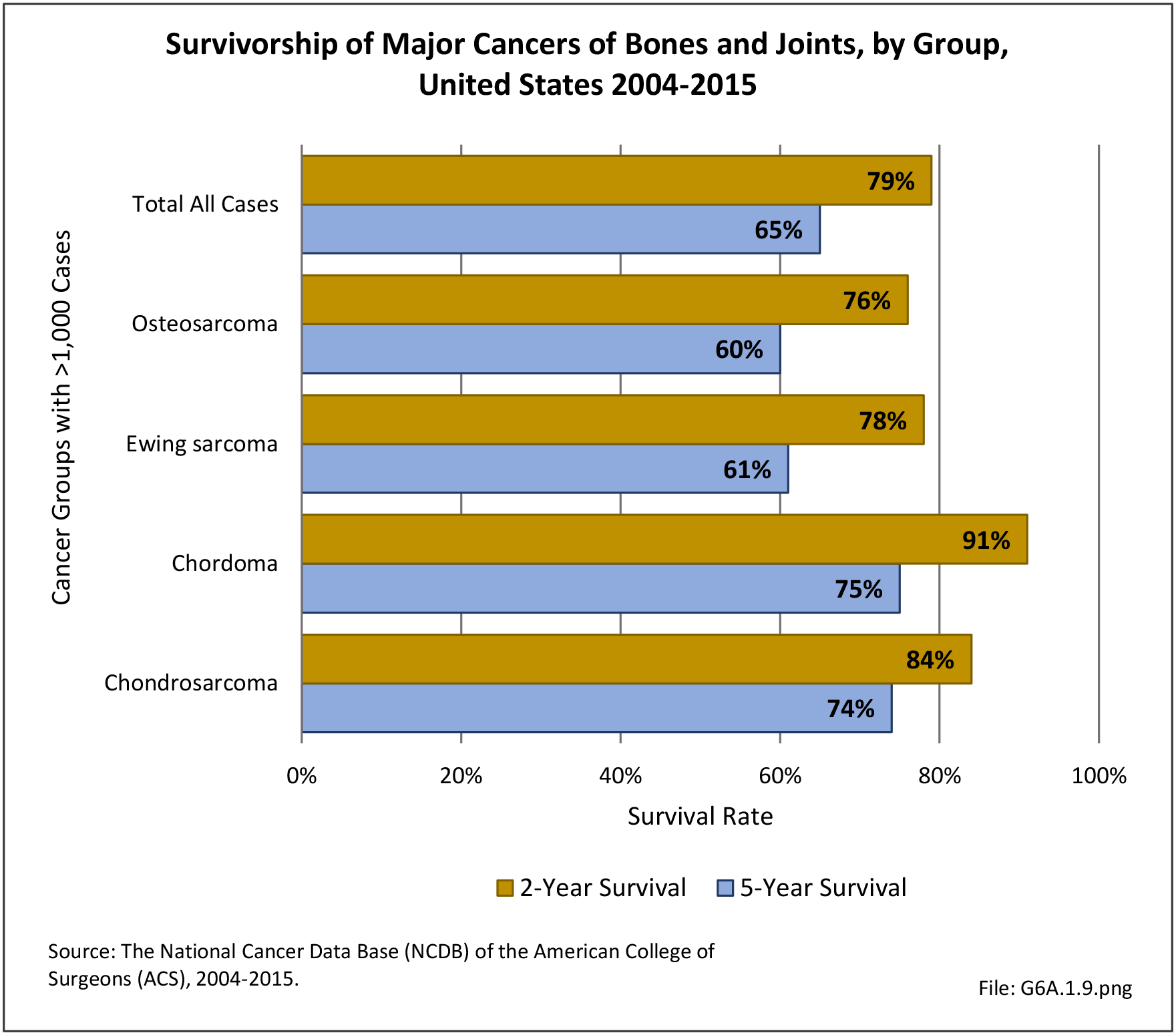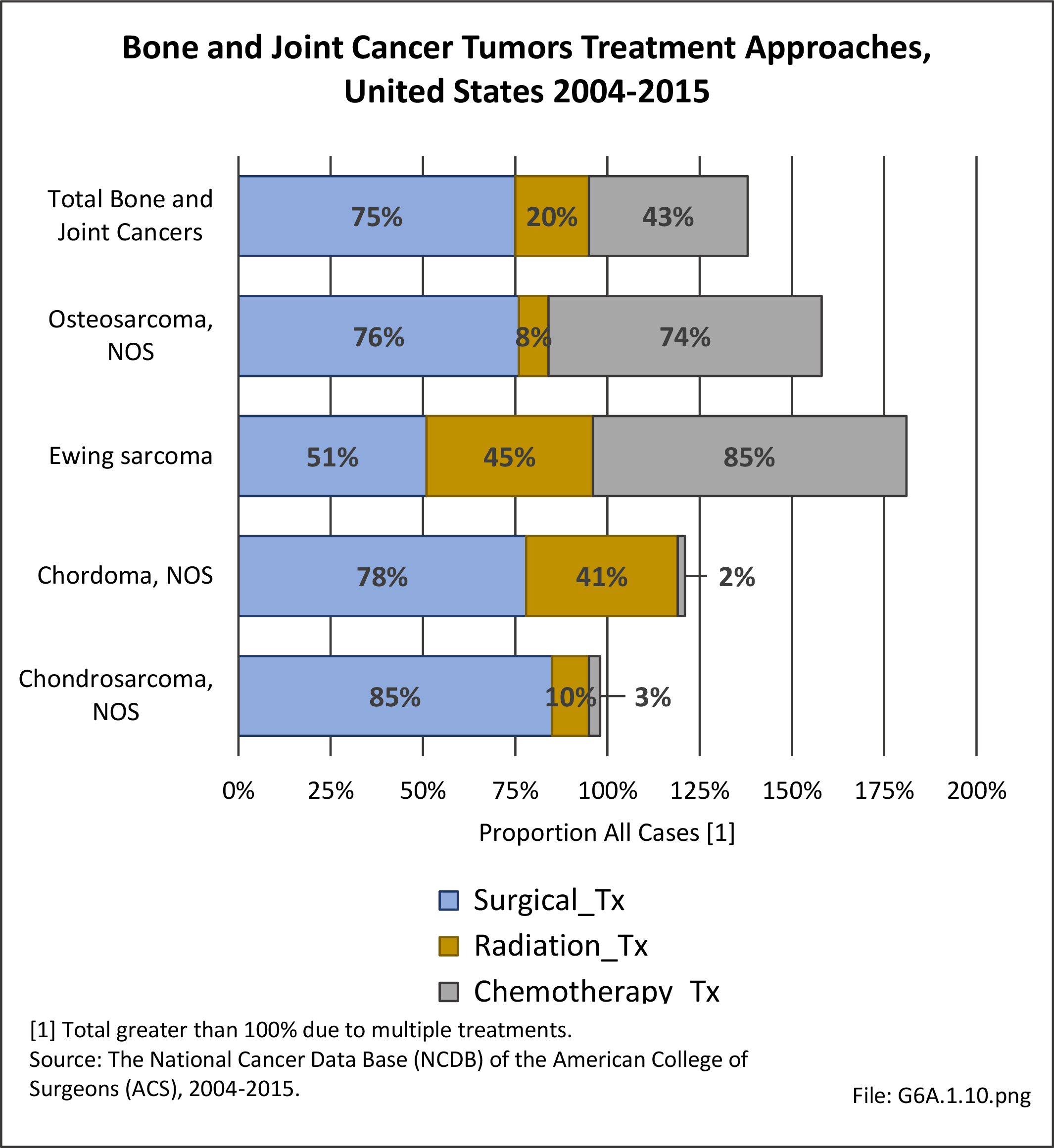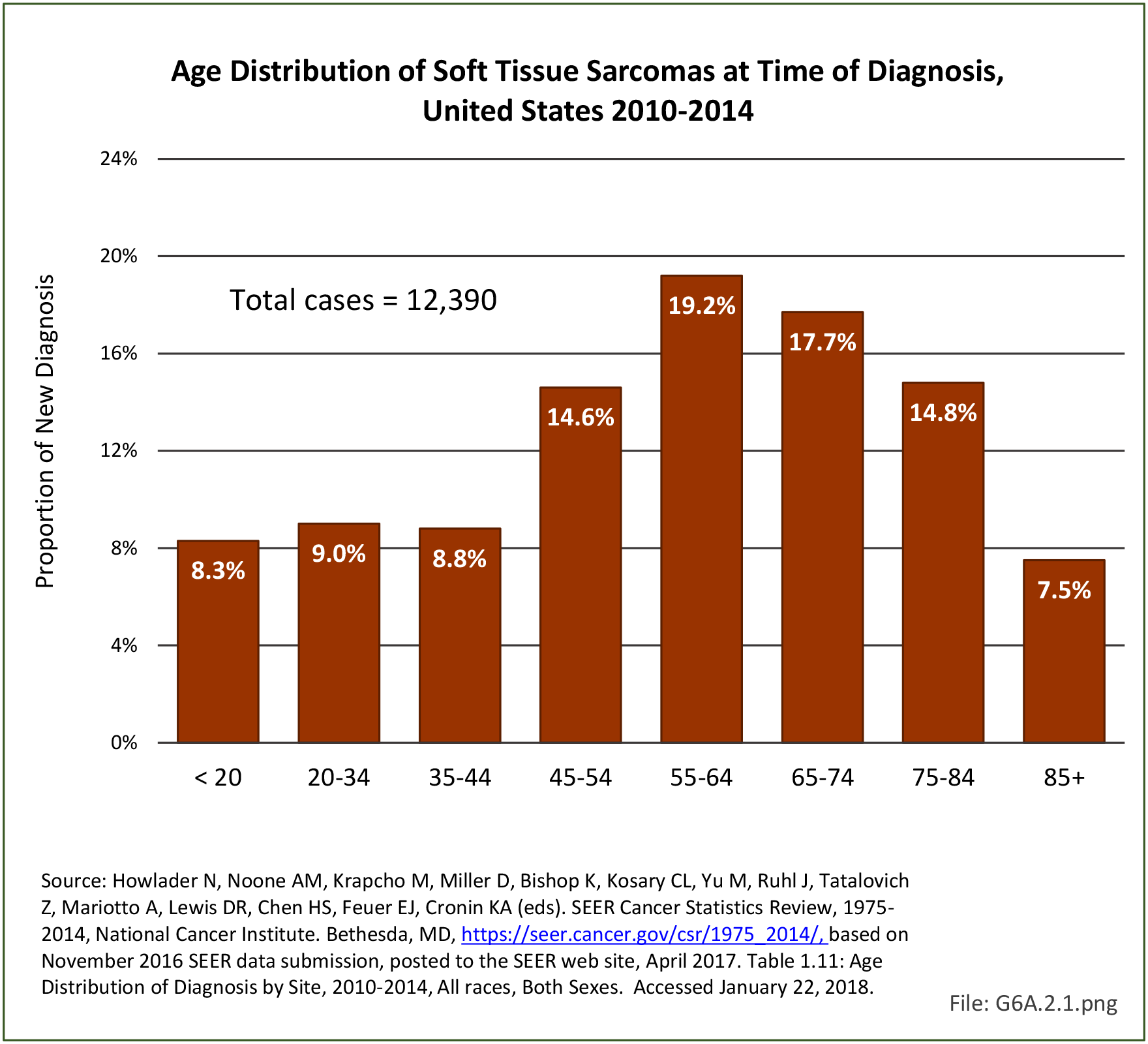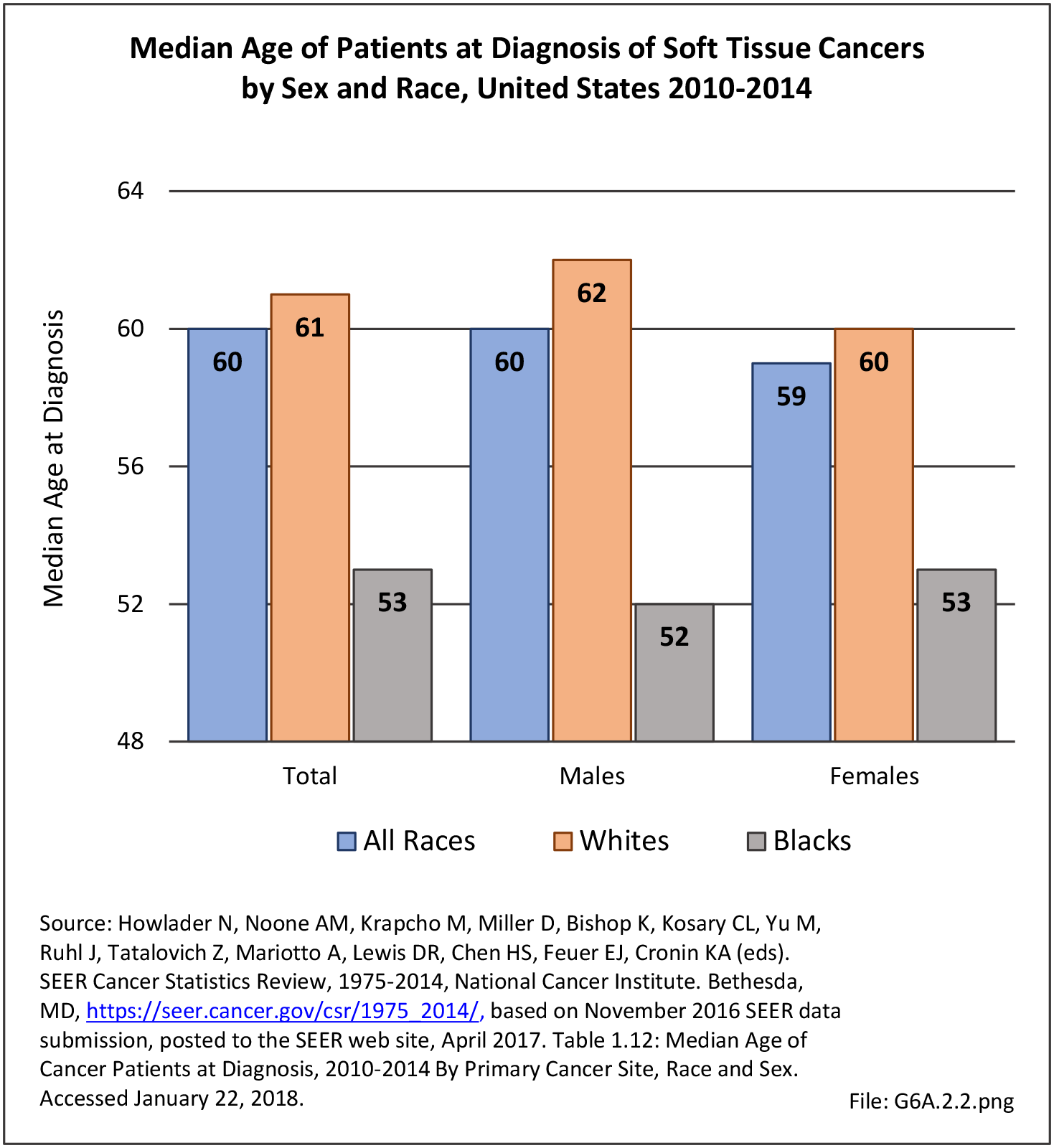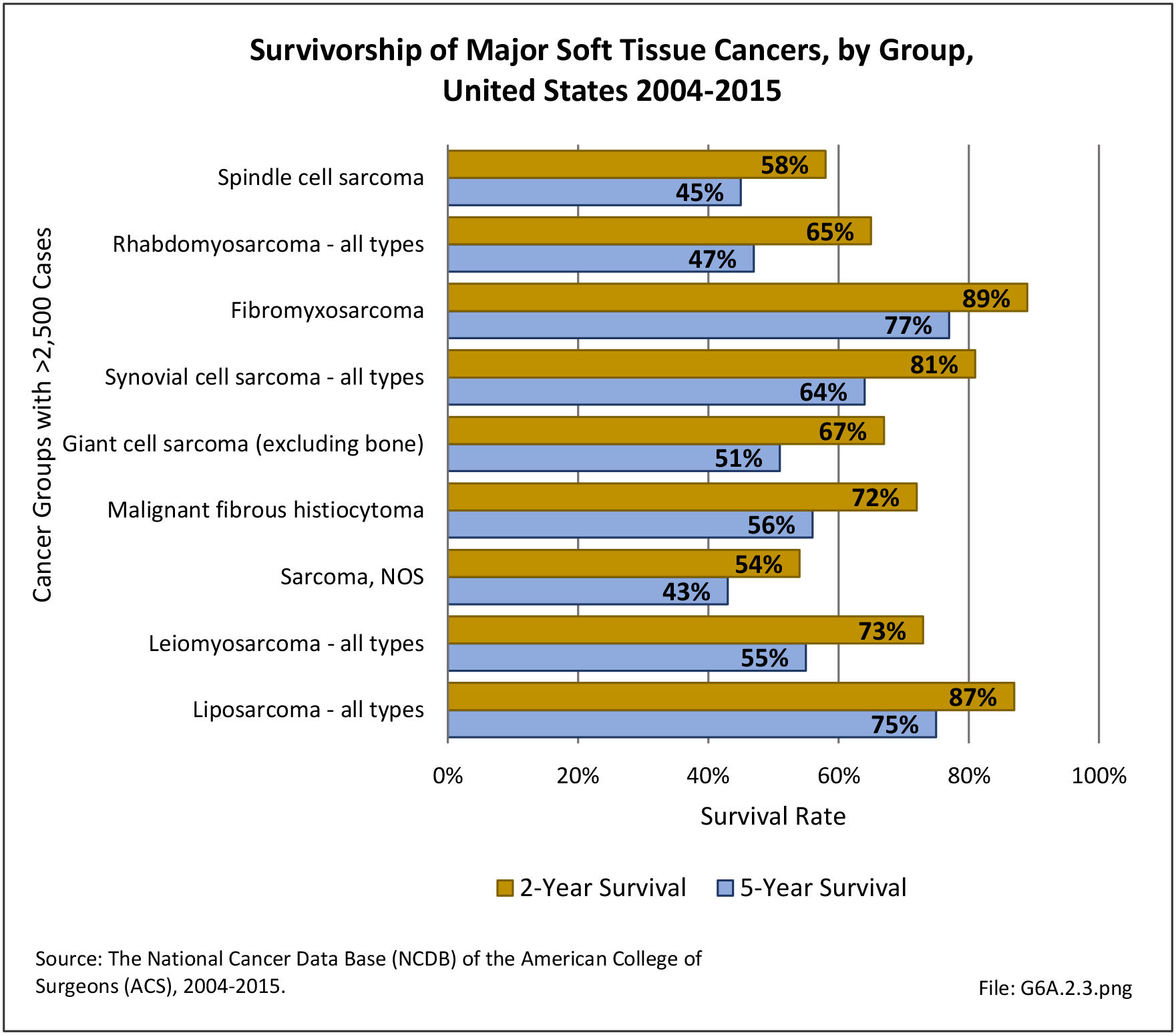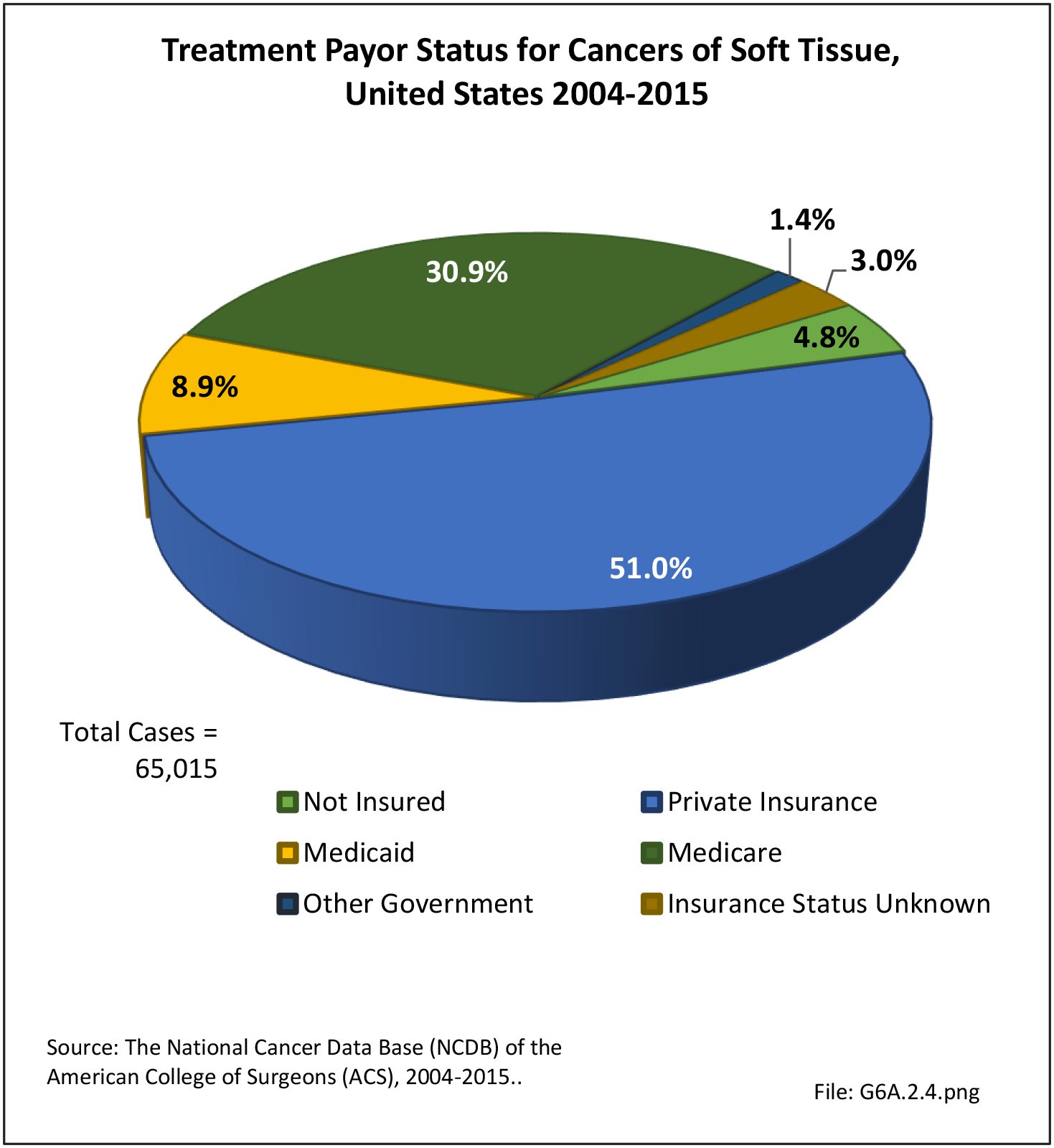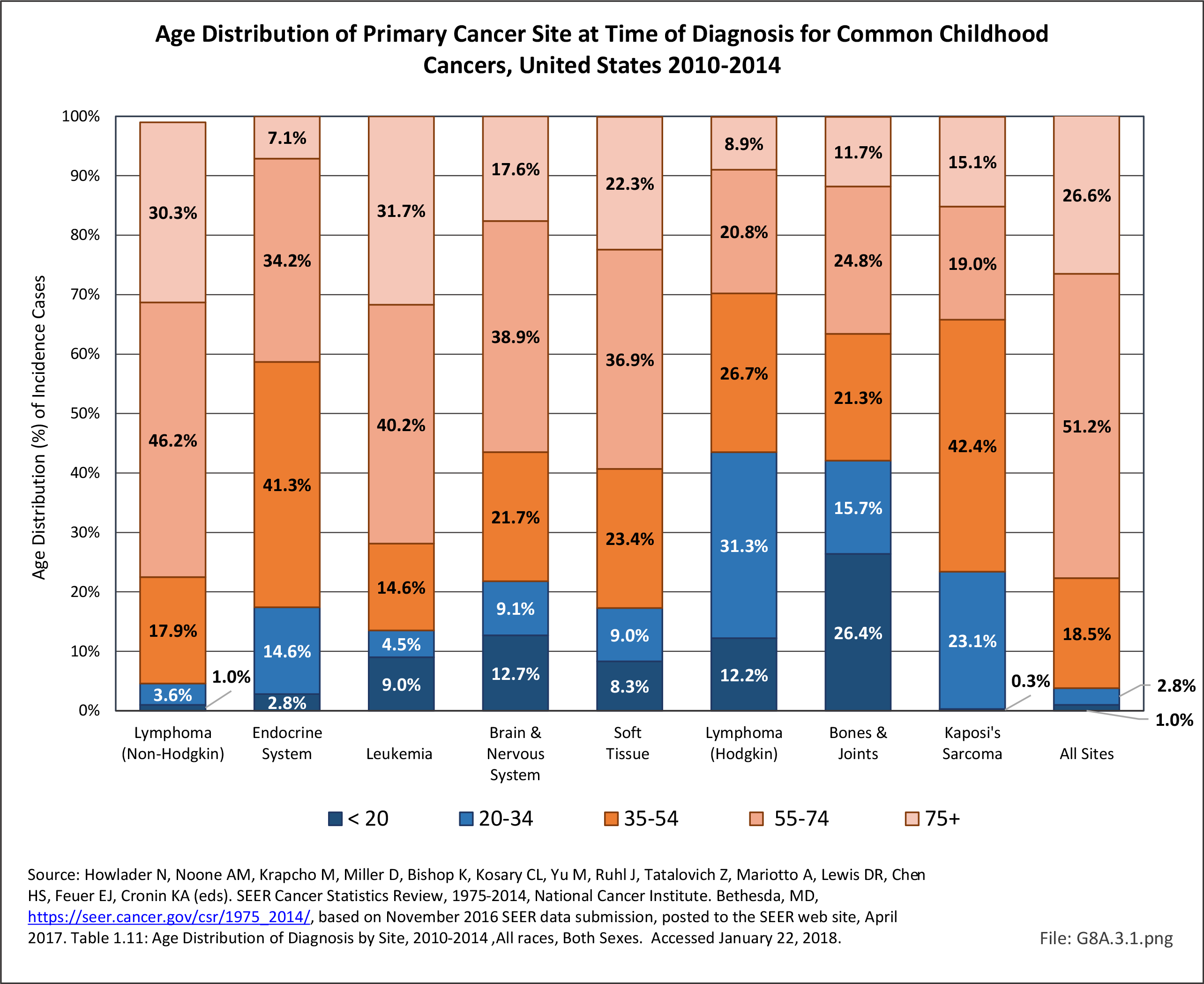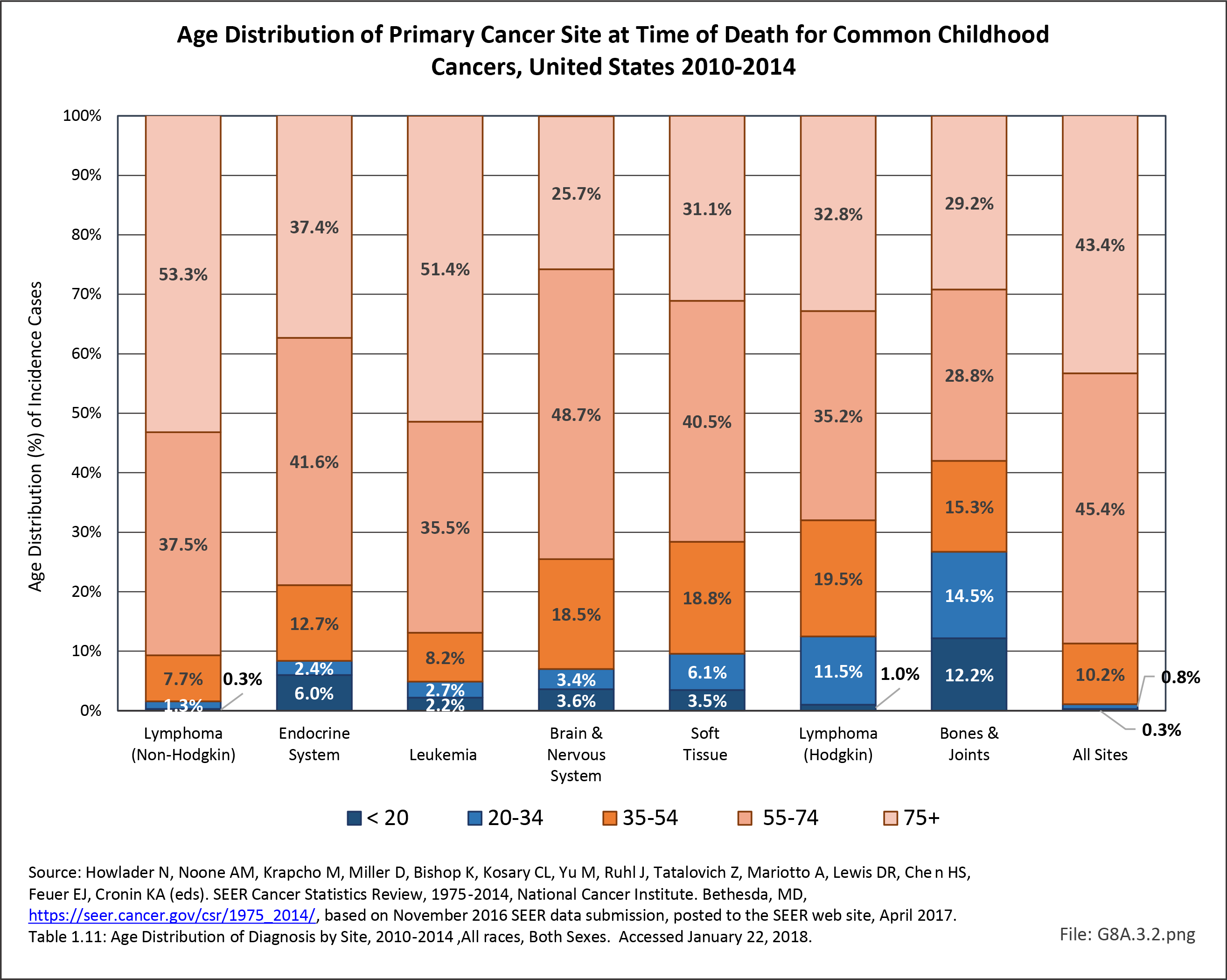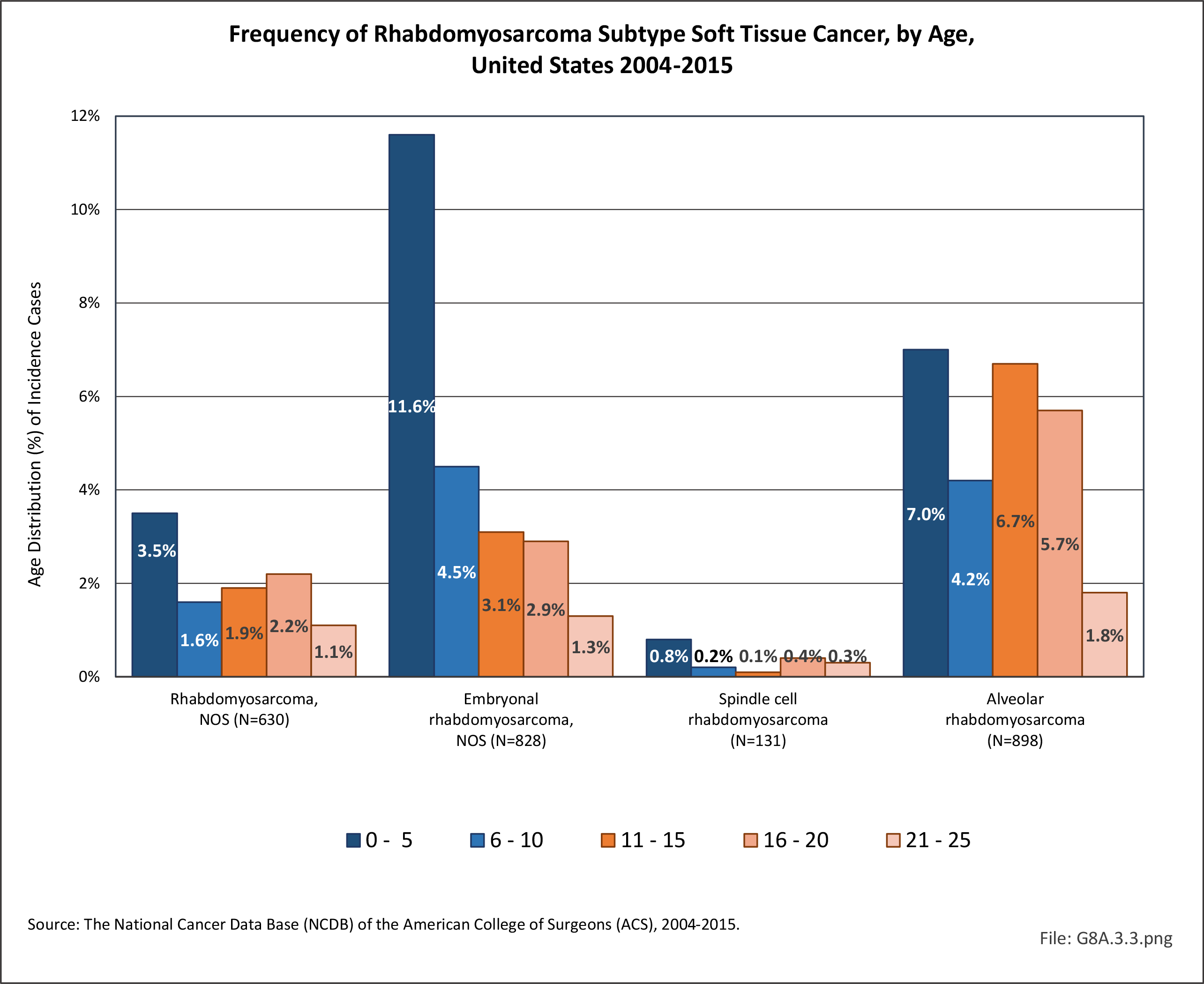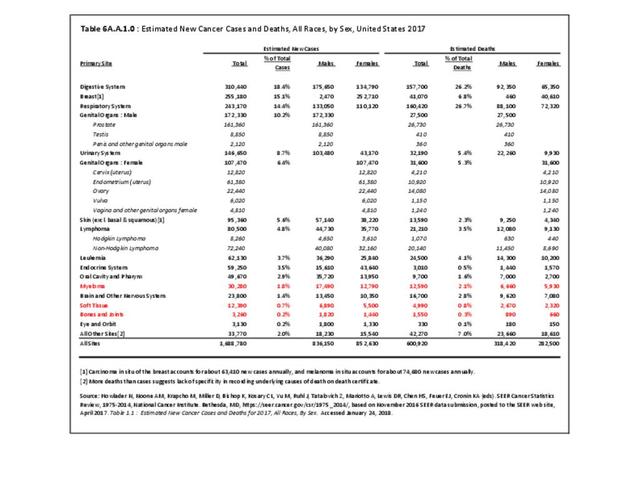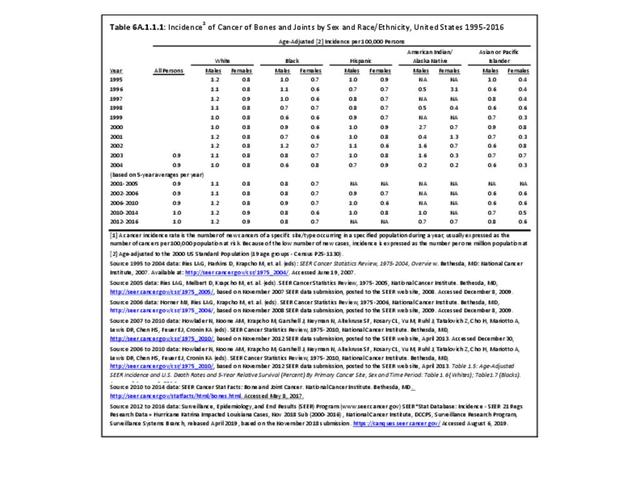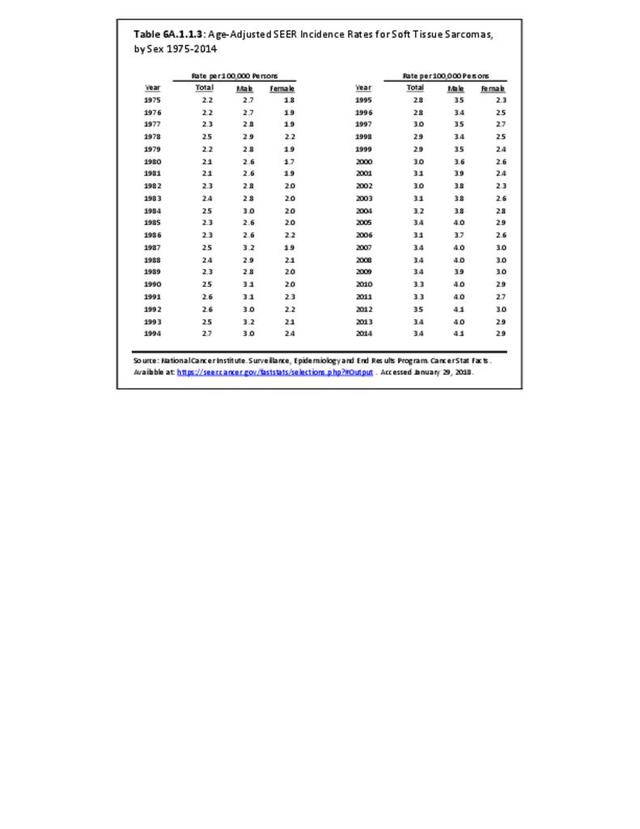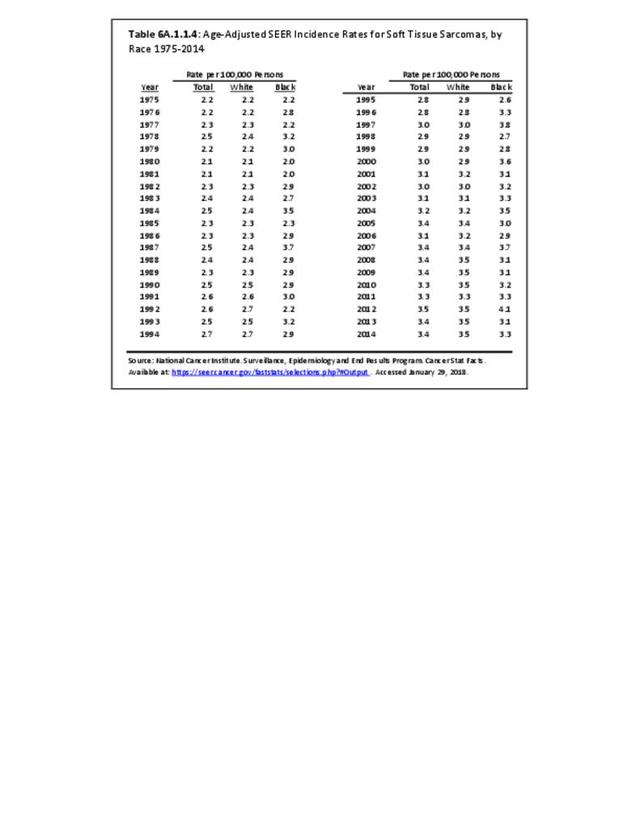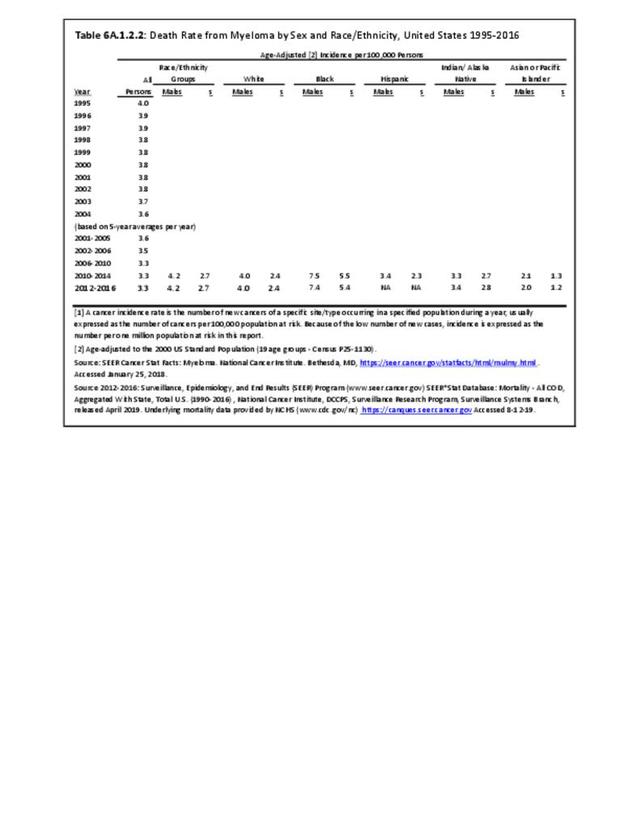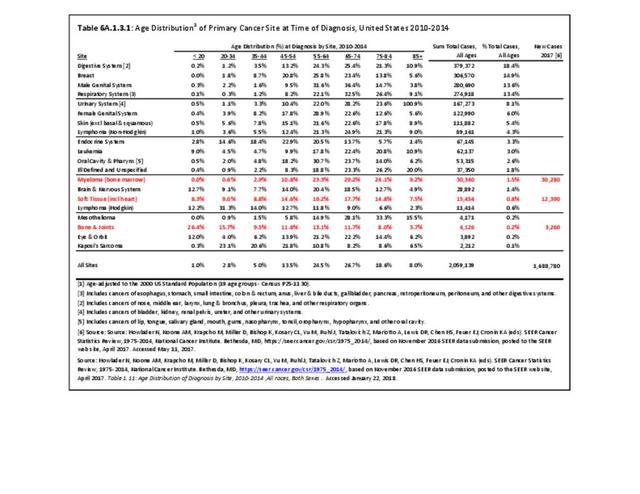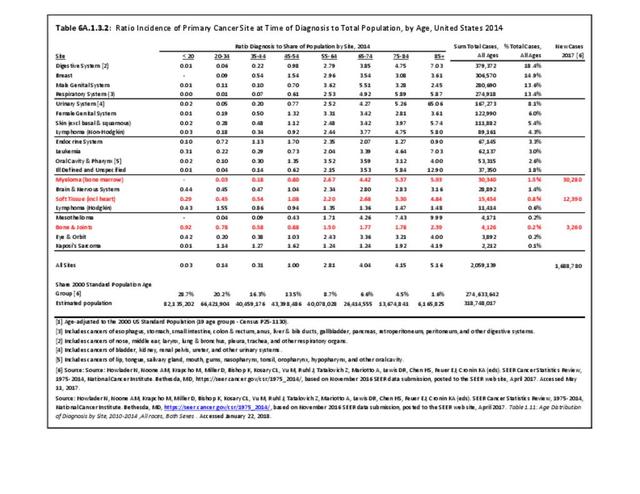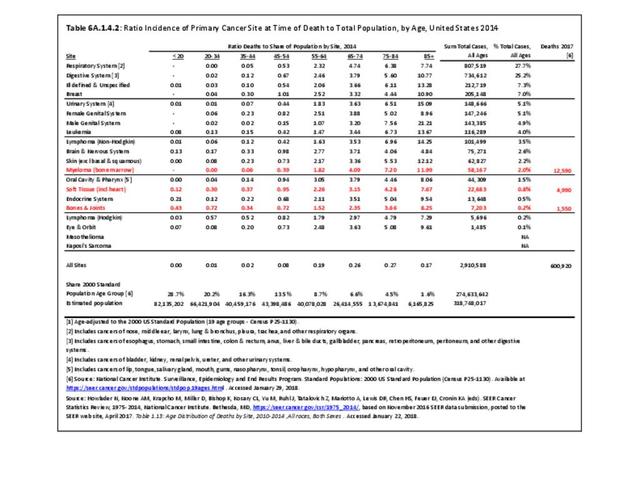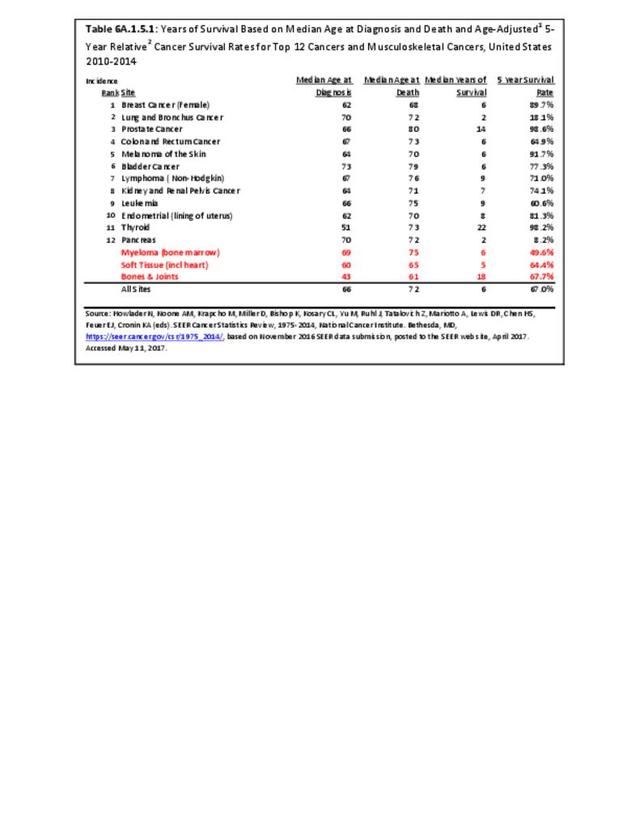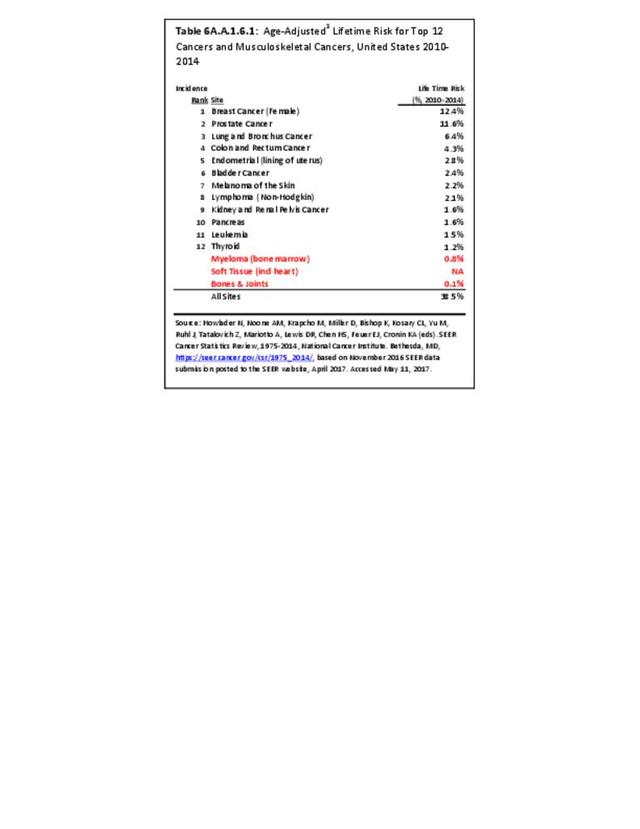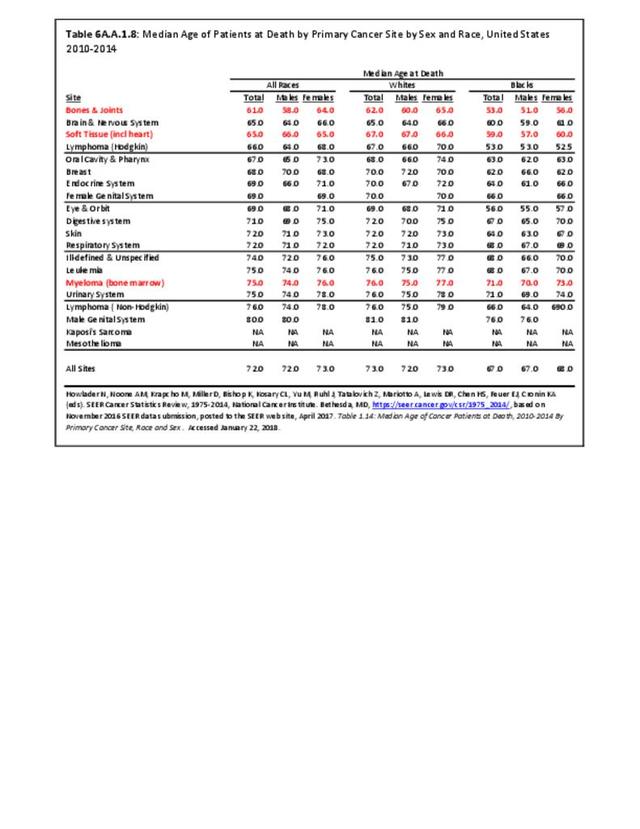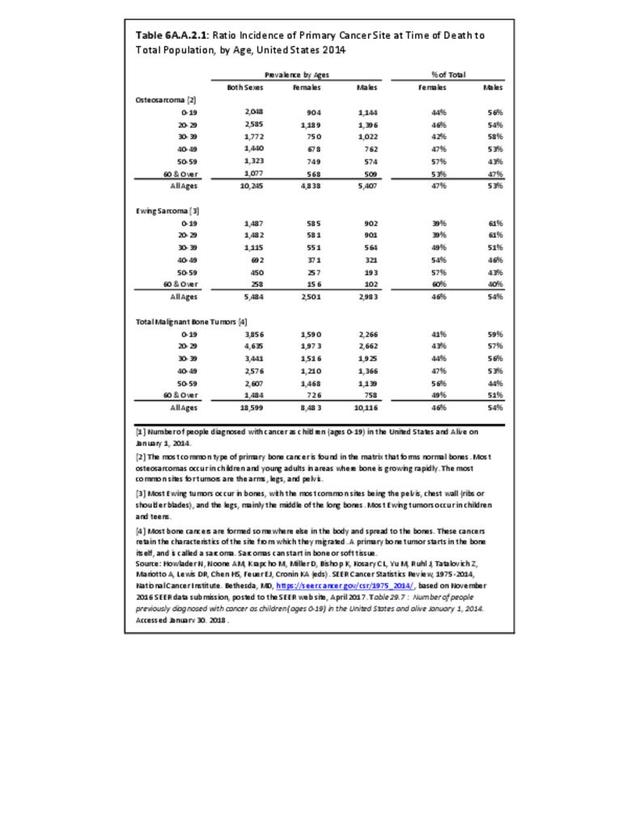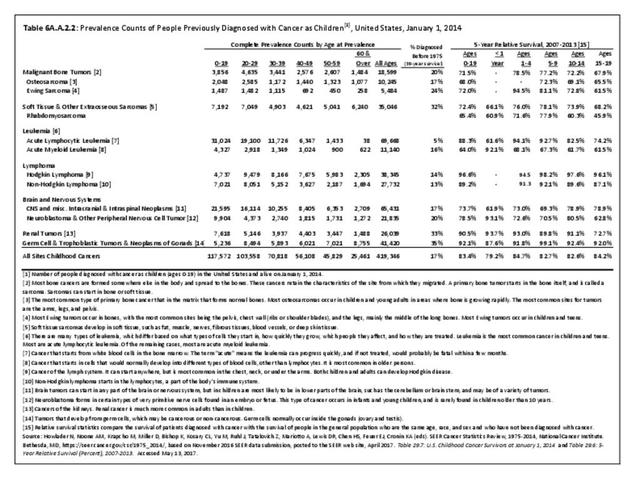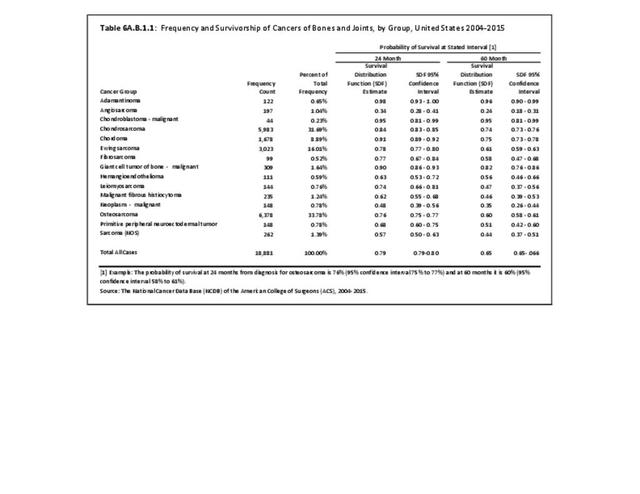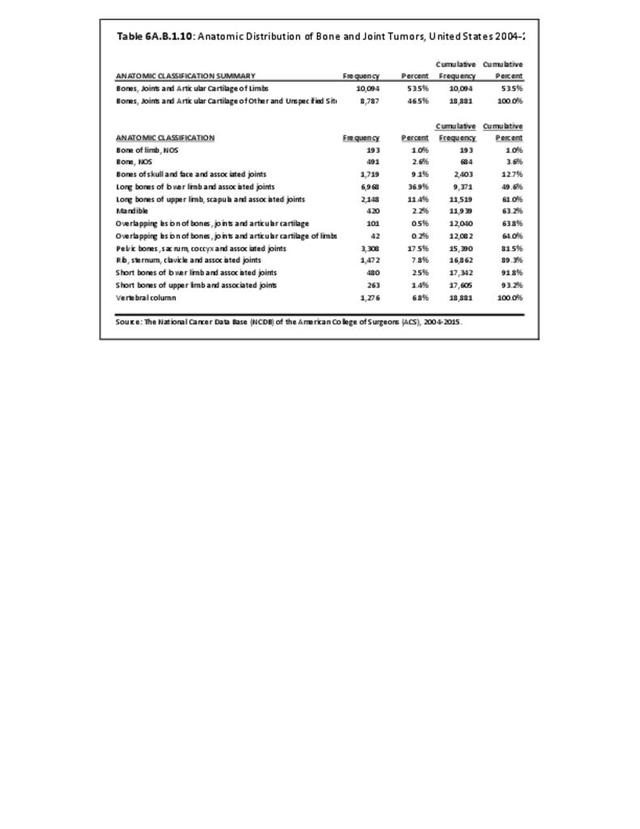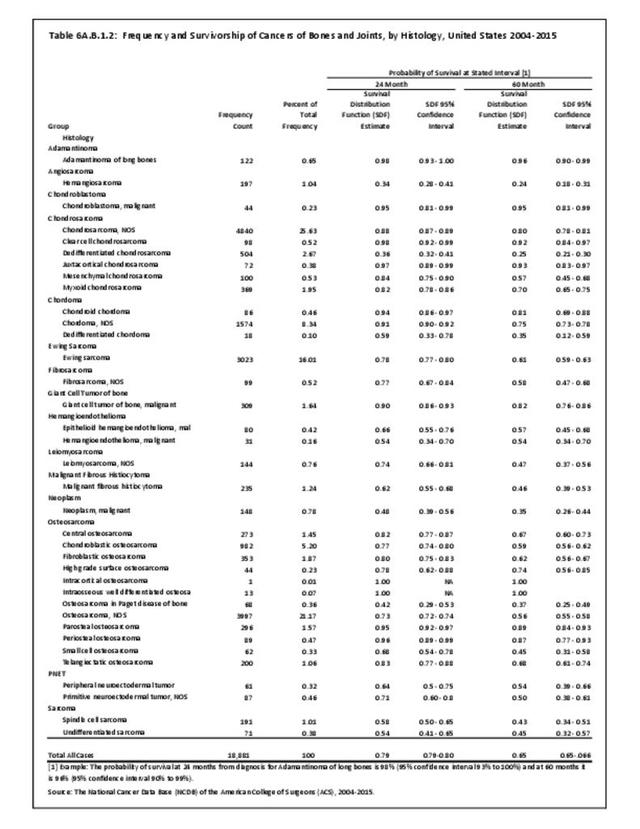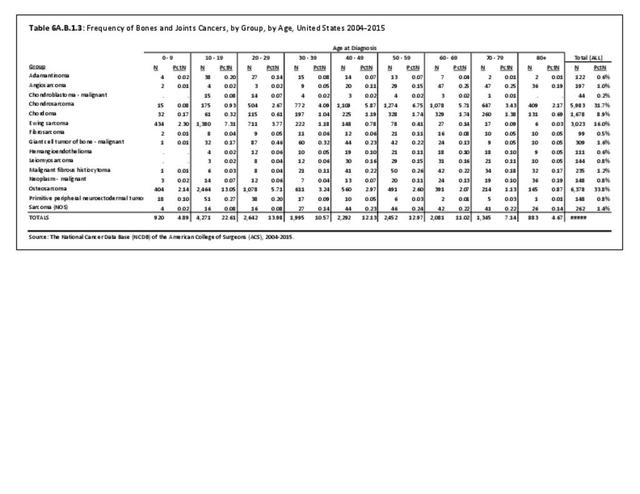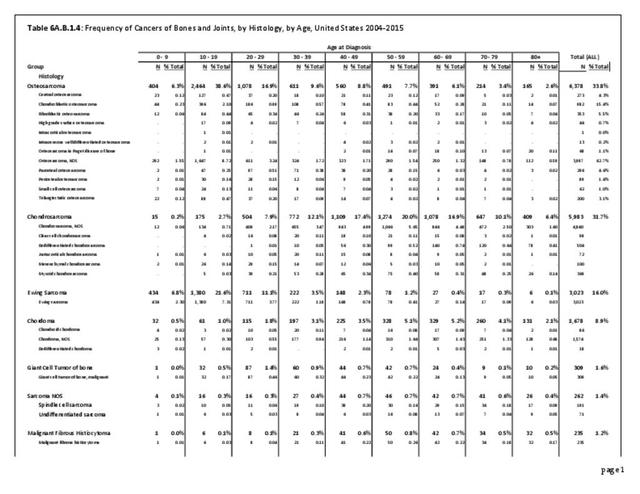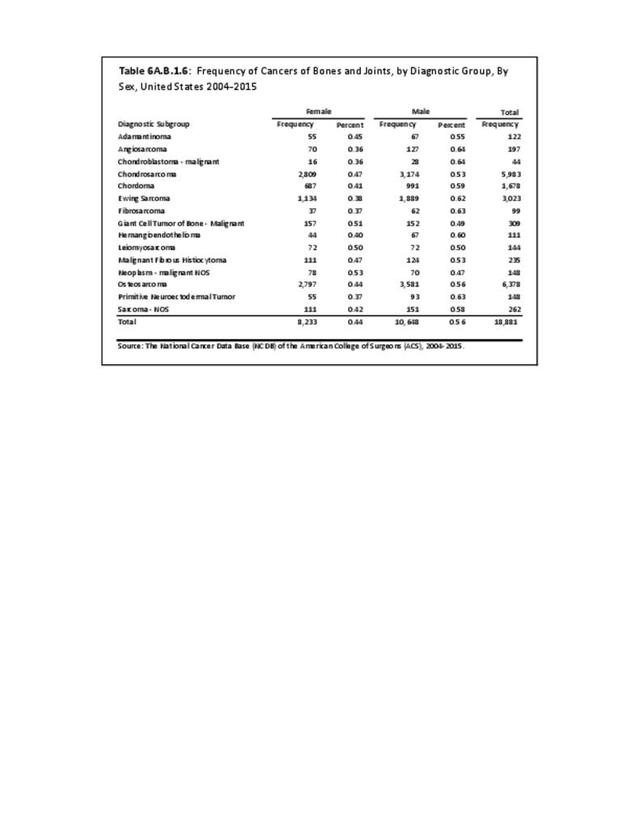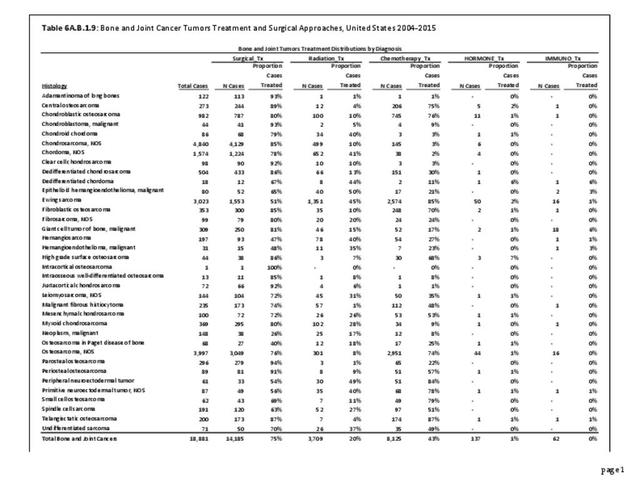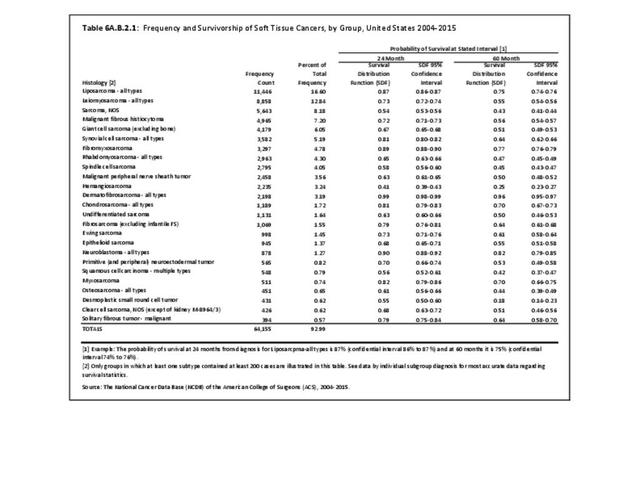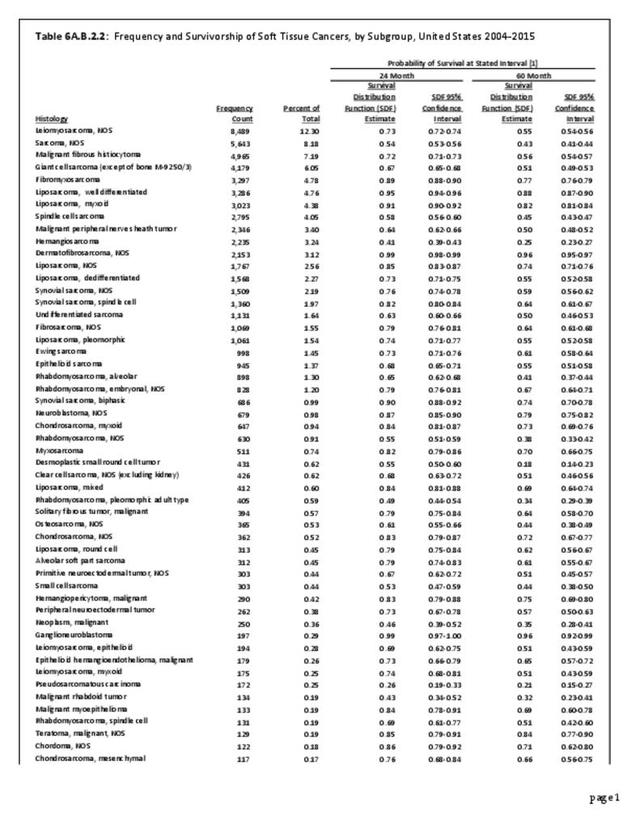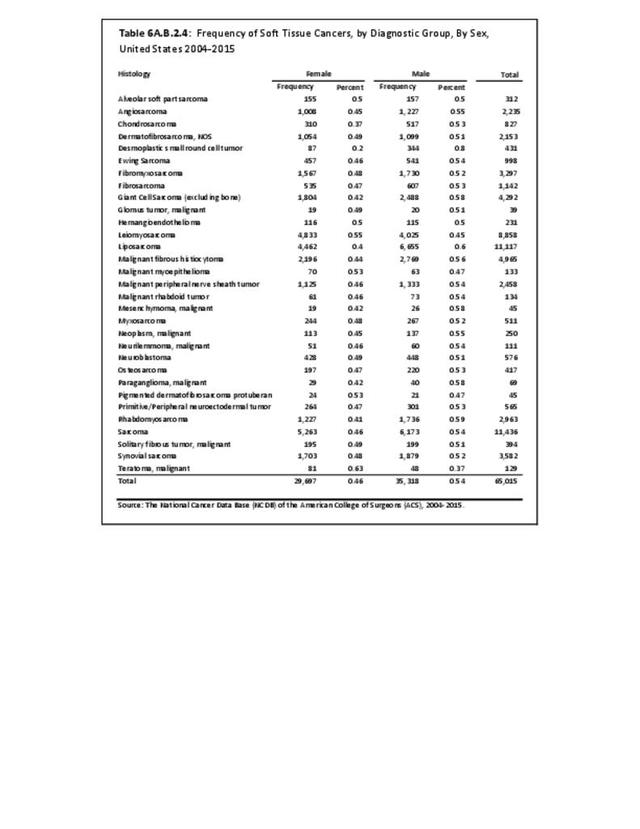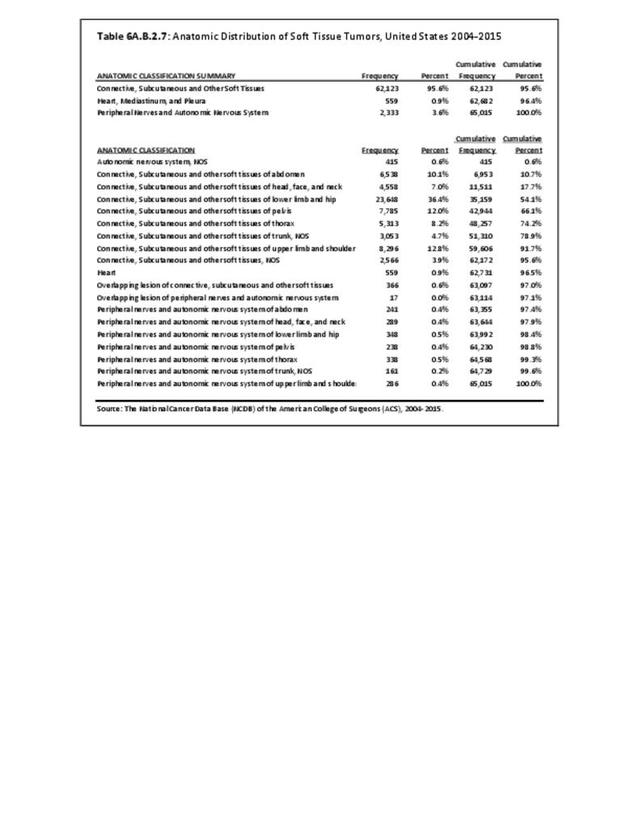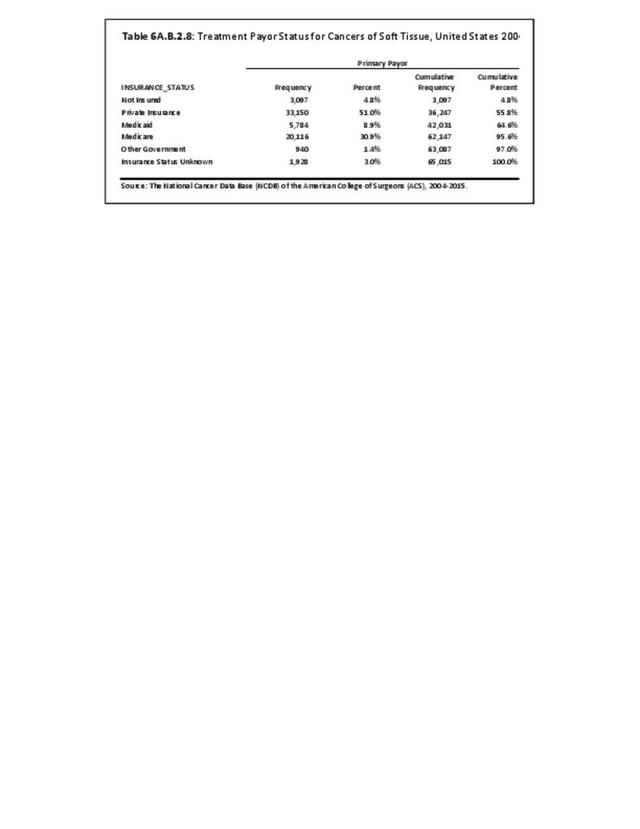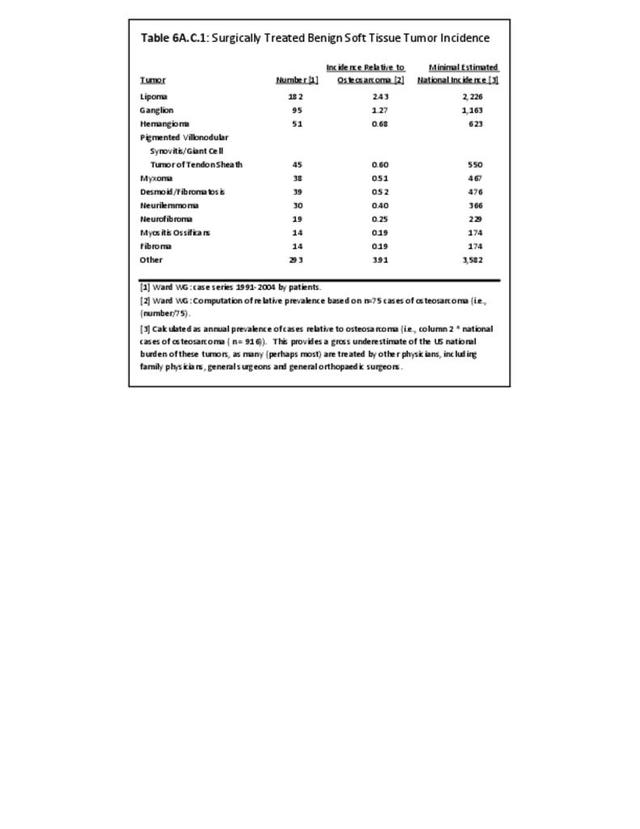Cancers of the musculoskeletal system affect both children and adults, but virtually all tumors have different age-based frequency. Myeloma, the cancer of the bone marrow, affects older persons more, while other bone and joint tumors are more prevalent in children and young adults. Soft tissue sarcomas affect all ages, but most are more common as persons reach middle age and later years. See individual cancer discussions for further information. In general, the older the patient, the poorer the prognosis and survival.
Childhood Cancers
Certain primary cancers of bones and joints (adamantinoma, osteosarcoma, Ewing sarcoma, and malignant giant cell tumor of bone) are found among people under the age of 30 years in higher proportion than expected for the overall incidence of most sarcomas. In 2010-2014, 42% of bone and joint cancers diagnosed were found in people under the age of 35 years, with more than 26% occurring among children and adolescents under the age of 20. This compares to 4% of all types of cancer sites found in people aged 35 years and younger, and only 1% in those younger than 20 years. Hodgkin lymphoma is the only other cancer to affect young people in similar numbers, with a higher percentage of cases diagnosed in the 20-year to 34-year age range. The average age at diagnosis for bone and joint cancers is 43 years, surpassed in youthfulness only by Hodgkin lymphoma, diagnosed at an average age of 39 years.1 (Reference Table 6A.A.1.3.1 PDF CSV; Table 6A.A.1.7 PDF CSV ; Table 6A.B.1.3 PDF CSV ; and Table 6A.B.1.5 PDF CSV)
Deaths from bone and joint cancers also are more common in people under the age of 35 years. Between 2010 and 2014, 12% of deaths from bone and joint cancer occurred in children and youth under the age of 20, and an additional 15% among young adults aged 20 years to 34 years. The mortality rate among children and youth under 20 years from bone and joint cancer comprises only 0.03% of deaths from all types of cancer, but 10% of cancer deaths in people under the age of 20 years and 5% of deaths among young people aged 20 to 34 years. The relative proportion of deaths from bone and joint cancers was higher in children, youth, and young adults than all other cancer types that disproportionately affect younger people, including brain and nervous system, leukemia, endocrine system, and soft tissue cancers. The average age at death for bone and joint cancers is 61 years, the youngest of all types of cancer. (Reference Table 6A.A.1.4.1 PDF CSV; and Table 6A.A.1.5.1 PDF CSV)
In 2014, osteosarcoma accounted for 55% of the malignant bone tumors in survivors diagnosed with cancer as children and alive on January 1, 2014. Nearly all the remaining bone tumors in survivors diagnosed as children and still alive had been diagnosed with Ewing sarcoma (30%). Among the childhood cancer survivors of all ages, 4.4% were survivors of bone tumors. (Reference Table T6A.A.2.2 PDF CSV)
Males were a greater proportion of the osteosarcoma survivors than were females until survivors reached middle age, when females were a larger share. Nearly one in four (22%) of the survivors had been diagnosed some 35 years ago. This is comparable with childhood cancer survivors for all types of cancer, where nearly one in four (23%) were diagnosed more than 30 years ago. (Reference Table 6A.A.2.1 PDF CSV)
Although not considered a childhood cancer, soft tissue sarcomas, which affect all ages, accounted for 8% of new diagnoses in the years 2010 to 2014 in children and young adults under the age of 20. Another 9% were found in the population age 20 to 34. Deaths from soft tissue sarcomas in this time frame were slightly lower but still accounted for a higher proportion of cancer deaths in the under 35 population (4% and 6%, respectively) than all except bone and joint cancers. (Reference Table 6A.A.1.3.1 PDF CSV and Table 6A.A.1.4.1 PDF CSV)
Rhabdomyosarcoma, a soft tissue sarcoma of the muscle mesenchymal cells, accounts for 3.5% of all new childhood cancers among children younger than 15 years and 2.0% of cases for youth aged 15 to 19 years each year. Half of the rhabdomyosarcoma cases are in children age 10 and younger. The 5-year survival rate when detected in children under the age of 15 is now reported at 67%, dropping to 51% for youth aged 15 to 19 years.2 This data demonstrates the relationships of survival to both age and diagnostic subset. In virtually all categories, survival decreases with age advancing beyond 10 years of age. (Reference Table 6A.B.2.3 PDF CSV)
Burden of Childhood Musculoskeletal Cancers
The high incidence and mortality rate of bone cancers among children, youth, and young adults creates a significant burden on the productivity and life of future generations. Apart from the financial costs, emotional toil, and lost lives from the initial treatments, survivors carry significant functional burdens and continuing care costs. With no differences found in survival rates between amputation and limb-salvage surgery, up to 90% of surviving bone and joint cancer patients are treated with limb-salvaging surgery.3 These surgeries most often require implantation of massive bone-replacing endoprostheses that have limited life span and compromised function, requiring periodic surveillance and revision surgery to repair or replace worn parts. The amputated survivors will require prosthetic limbs, the function of which is clearly limiting in comparison to normal activity. Furthermore, due to wear and tear of these artificial limbs, as well as changes in the amputated stumps themselves of the survivors’ limbs, these prosthetic limbs will require ongoing costly repairs, revisions, and replacements over the years.
Both procedures are expensive. The cost estimate nearly 20 years ago was $25,000 per year for artificial limb replacement of an amputated limb in an active 20- to 30-year old man in 1997 dollars. The cost estimate was $23,500 for implant, rehabilitation, monitoring, and replacement with limb salvaging endoprostheses.4 A 1994 study comparing hospital and professional fees reported higher costs of $59,214 for the Ilizarov method of limb salvage via lengthening of the remaining parts versus $30,148 for amputation, but cited lifetime prosthetic costs of $403,200.4 Both estimates are limited by sample size and actual knowledge of long-term maintenance costs, but more recent cost estimates are not available. A 2008 study of functional outcome found no clear evidence that one procedure, limb-salvage versus amputation, provided a better functional outcome.5 Due to chronic pain and overall dysfunction, a large number of survivors, regardless of treatment, will end up on disability, requiring public support for the majority of their adult lifetime.
Musculoskeletal Cancers of the Aging
More than 60% of myeloma cases are diagnosed in persons age 65 years and older. This is a similar rate to respiratory and urinary system cancers, both of which disproportionately affect older persons. Soft tissue cancers affect all ages, and in relatively equal proportion in the middle and older years (ages 45 to 84 years). As previously discussed, bone and joint cancers affect a disproportionate number of younger persons and are not considered a major cancer of aging unless in a metastatic form. However, when comparing the share of cases to cohort population size, most cancers have a higher ratio as aging occurs. (Reference Table 6A.A.1.3.1 PDF CSV and Table 6A.A.1.3.2 PDF CSV)
Because of the advanced age of many myeloma patients, 78% of deaths from myeloma occur in the 65 and older population. Fewer than 50% of patients survive 5 years after diagnosis, although the long-term survivors skew the average survival time up to 6 years. Soft tissue cancer deaths occur about equally in people under 65 years and those 65 years and older. Deaths from bone and joint cancers have the lowest rate in the 65-year and older population of all cancers since it affects younger persons at a high rate. Again, when compared to the cohort population size, the ratio of deaths increases with age. However, the 2 and 5 year survivorship of both bone and joint as well as soft tissue sarcomas decreases as one ages. (Reference Table 6A.A.1.4.1 PDF CSV; Table 6A.A.1.4.2 PDF CSV; and Table 6A.A.1.5.1 PDF CSV)
Burden of Musculoskeletal Cancers of the Aging
The average age of the population in the United States continues to rise. With aging, the human body's ability to cope with stress and illness declines. As a result, poorer outcomes from cancers are expected in the aged due to greater decline in functional status, adaptability, and an increase in co-morbid conditions. All these factors effect survival.
- 1. National Cancer Institute. Surveillance, Epidemiology, and End Results Program. Cancer Stat Facts: Hodgkin Lymphoma. Available at: https://seer.cancer.gov/statfacts/html/hodg.html . Accessed January 30, 2018.
- 2. National Cancer Institute. Childhood Rhabdomyosarcoma Treatment – Health Professional Version. Available at: https://www.cancer.gov/types/soft-tissue-sarcoma/hp/rhabdomyosarcoma-tre... . Accessed January 31, 2014
- 3. American Cancer Society. Surgery for Bone Cancer. Available at: https://www.cancer.org/cancer/bone-cancer/treating/surgery.html . Accessed January 31, 2018.
- 4. a. b. Grimer RJ, Carter SR, Pynsent PB. The cost-effectiveness of limb salvage bone rumors. J Bone Joint Surg Br 1997;79:558-561
- 5. Barr RD, Wunder JS. Bone and soft tissue sarcomas are often curable-but at what cost? Cancer. 2009;115(18):4046-4054.
Edition:
- Fourth Edition


